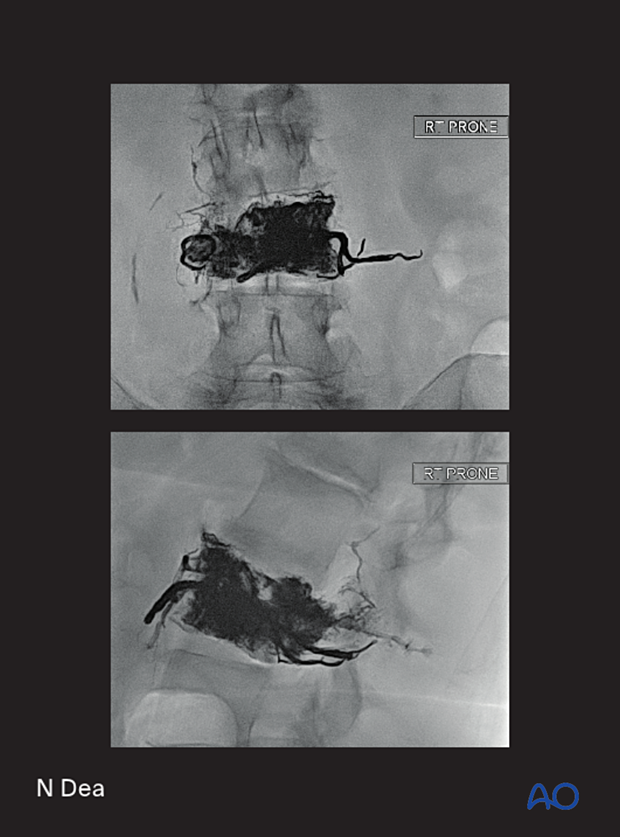Percutaneous treatment (embolization)
1. Introduction
Preoperative selective arterial embolization is indicated for all primary hypervascular tumors to decrease the risk of intraoperative bleeding, reducing resection risk.
There are some specific considerations for aneurysmal bone cyst and hemangioma.
2. Aneurysmal bone cyst
Aneurysmal bone cysts are usually vascular tumors. Surgical resection is usually the mainstay of treatment.
When surgery is considered, preoperative embolization is required.
However, selective arterial embolization can also be a stand-alone treatment.
Multiple embolization sessions are, however, required. A downside of repeated embolization is radiation exposure to the patient, especially in the pediatric population. Nevertheless, a good response to this stand-alone treatment has been reported.
Based on these findings, the AO Spine Knowledge Forum Tumor recommended (weak recommendation and very low quality of evidence) that selective arterial embolization might be considered as a stand-alone treatment of an aneurysmal bone cyst.
Sclerotherapy has also been shown to be a safe and effective mode of treatment with a lower radiation exposure.
Reference:
- Dalili D, Parker J, Mirzaian A, et al. Aneurysmal bone cysts in the spine, causing neurological compromise: safety and clinical efficacy of sclerotherapy utilizing sodium Tetradecyl sulfate foam. Skeletal Radiol. 2021 Dec;50(12):2433-2447.
Other percutaneous treatments of ABC like bone marrow aspirates, demineralized bone matrix, and doxycycline are not recommended.
Recommended reading:- Charest-Morin R, Boriani S, Fisher CG, et al. Benign tumors of the spine: has new chemotherapy and interventional radiology changed the treatment paradigm? Spine 2016;41 (Suppl 20):S178–185.

3. Hemangiomas
Spinal Hemangiomas are more often than not asymptomatic and incidental findings. Evidence suggests that only 1% of spinal hemangiomas become symptomatic, with 55% presenting with pain and 44% with progressive neurological compromise.
Excellent local control is achieved with aggressive intralesional resection. Percutaneous treatment, however, also plays an essential role in the treatment of hemangiomas. Multiple options have been used with varying degrees of success.
Endovascular embolization is crucial preoperatively as these tumors tend to be very vascular.
Percutaneous vertebroplasty with PMMA has relieved pain from vertebral hemangiomas with some success.
Transpedicular injection of ethanol has also been used in its management.
Lastly, radiation therapy can be considered, although controversy exists regarding the long-term consequences of radiation therapy for these benign tumors.
The picture shows an aggressive hemangioma treated with selective arterial embolization and percutaneous vertebroplasty.














